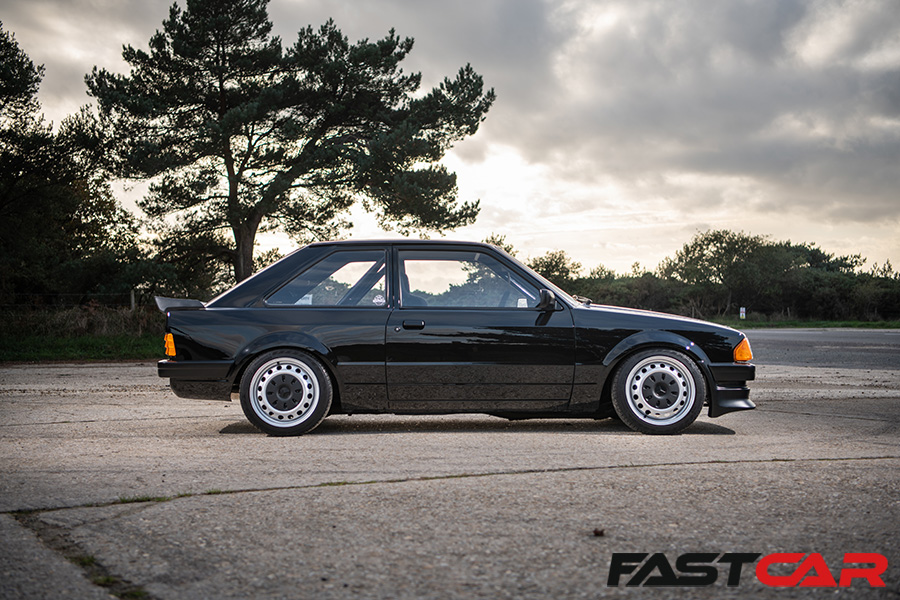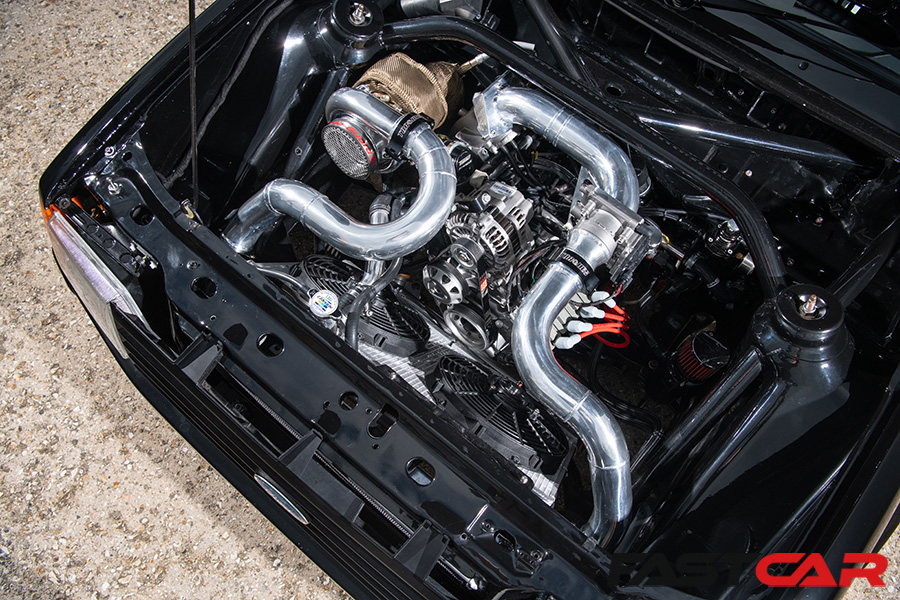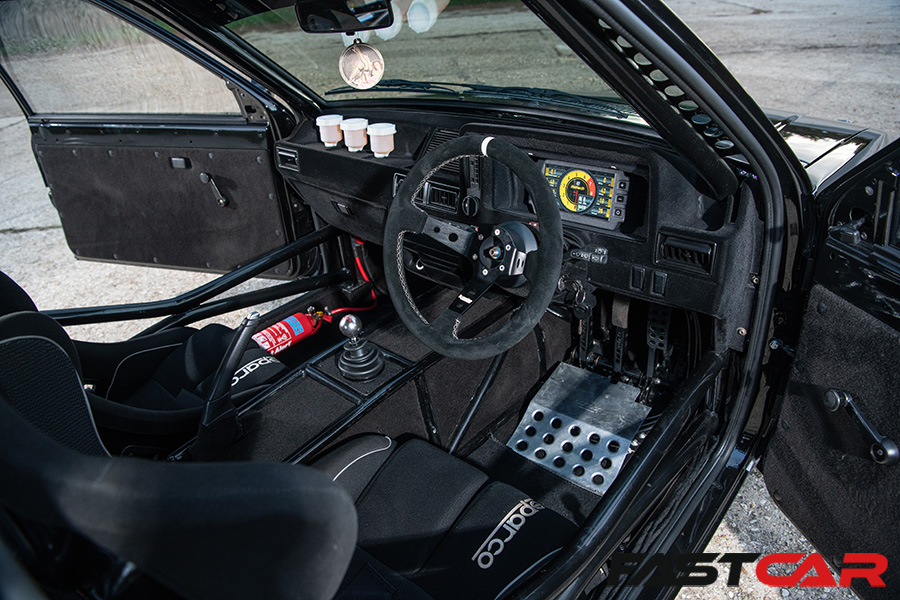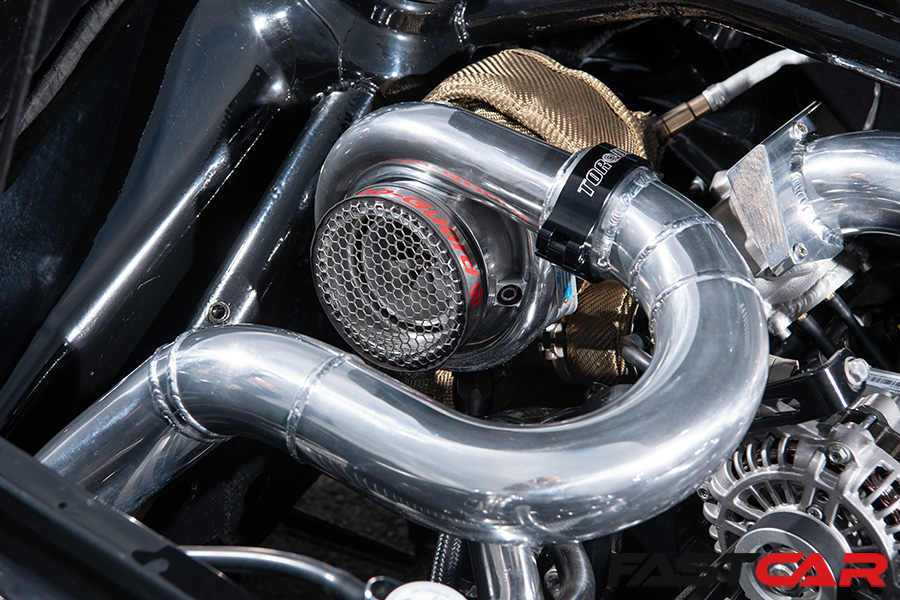You might not suspect it, but Liam Stolton’s Ford Escort Mk3 is hiding a rotary-powered surprise complete with RWD conversion.
Modifying a car for both show and go is a desirable fusion. It’s not for everyone; some people like to make gleaming show-stoppers out of relatively underpowered bases, on the grounds that they’re built for cruising – if you’re going too fast, nobody will see you. Others build outright performance machines without paying much heed to the aesthetics – nobody will see you anyway because you’re going so fast. But the sweet spot for people like Liam Stolton lies in the centre of the Venn diagram: cars that are as fabulous to behold as they are breath-taking to drive.
Watch the video feature of Liam’s Rotary-powered Ford Escort Mk3.
Liam’s previous fast Ford builds
His previous masterpiece demonstrated this ethos perfectly: a Mk2 Fiesta with extreme aero and a supercharged Zetec, gleaming like a concours sweetheart. “I’ve always been into my old Fords, from a young age,” he explains, “and following in my brother Martin’s footsteps is where it all started. I was always working on them with him before I could even drive. It all started for me driving a stripped-out and rollcaged Mk2 Fiesta with an 1800 Zetec, which was a laugh until it got written off when it was parked up outside work.
There was something about old Fiestas that I loved so much.” This passion led to the inception of the revered Stolton Engineering, who regular showgoers will no doubt be familiar with because, dammit, they’re always there. The fellas love to get out and about, chatting to fellow petrolheads about what they’ve been up to and what’s in the pipeline. And if you’ve bumped into the Stoltons at a show recently, you’ve probably spotted this pristine rotary-powered Ford Escort Mk3.

Photography: Ade Brannan
Buying the Ford Escort Mk3 1.3GL
“I bought this car from a friend for £50 around eight years ago, as he needed it gone,” says Liam. “It was just a bare rolling GL shell in blue, which a homeless guy had decided to help himself to live in for a short time and destroyed what was left inside! Overall the shell was tidy, and minimal rust repairs were needed. I didn’t have any immediate plans for it though, and it ended up sitting in our yard for several years before I decided I wanted to do a budget RWD conversion.”
That’s right – despite the impressive spec and impeccable finish, this whole project has been brought together with a tight set of purse-strings, as Liam was keen to explore some fresh and offbeat avenues of problem-solving rather than building a quick Mk3 along established lines. And while the rear-drive conversion is a reasonably well-trodden path, it’s fair to say that you don’t come across such a thing with a Wankel rotary engine in it every day.

Photography: Ade Brannan
Rotary-powered Ford Escort Mk3 body to RX-8 subframe
“The Mazda connection just made sense to me,” he reasons. “I sourced a donor RX-8 on the basis that it was RWD, manual, and with a factory-fitted LSD – and it only cost me £600. What’s more, when the donor car was stripped of all that I needed, everything left over was sold on to pretty much cover what I’d paid. I used as much as I could to keep costs down.”
Naturally the most intriguing part of this whole conversion is the Wankel rotary engine. Liam fully rebuilt it, and in the current spec he estimates it’s putting out around 300bhp, having road-mapped it himself. And the fun part is blowing people’s minds when he points out that the original 1.3 badge on the bootlid is still technically accurate, kinda. You see, when it comes to piston-less rotary engines, the question of displacement is something that often baffles people.

Photography: Ade Brannan
The difference between rotary and piston engines
The truth of it is that describing it in such terms is a nonsense, rotary engines and traditional piston engines aren’t directly comparable in that way. Sure, the rotary engine shares the traditional four-stroke principle – intake, compression, combustion, exhaust (or ‘suck, squeeze, bang, blow’) in each cycle – but that’s where the similarities end. If you really want to think of it in terms of a piston engine, picture a rotary as having just one big cylinder; this is really an oval-shaped chamber, with a spinning rounded-triangular rotor inside it. This spins elliptically around an axle which runs through the centre of the chamber, and the nature of the ellipsis creates three separate sections within the chamber as the rotor spins around.
The air-fuel mix gets injected into the first of these sections, which is then transported and compressed by the spinning rotor into the second section, where it’s ignited. This combustion keeps the rotor spinning, pushing the spent gases to the exhaust section to be expelled. The brilliance of this design is that there are only two moving parts – the rotor, and the axle it’s located on. Think about how many moving parts there are in the valvetrain and bottom end of a piston engine, the difference is really quite remarkable. This allows a rotary engine to be around a third of the size and weight of a piston motor.
The drawbacks of rotary engines
It’s not a perfect design, however; the extreme temperature differences between the chamber sections are what cause the rotor seals to wear quickly, and these engines use a lot of oil as this gets injected relentlessly into the chamber to protect the seals. That’s why you often see dodgy rotary-powered cars selling cheap – owners can neglect the oil levels, and the engines start to eat themselves. But if you’re canny, like Liam, and you’ve got the skills to rebuild the motor into something spicy, then a previous owner’s neglect can become your jackpot.

Photography: Ade Brannan
Modifying the Ford Escort Mk3
“All of the work was pretty much carried out by myself over a period of about two years, of which around six months of that it was sat in storage,” Liam continues. “A big hole was cut down the centre, and I started mocking up the running gear from there. The fabrication side of things was fairly straightforward; I’m still using the powerplant frame linking the gearbox and rear diff together, so it acted as a skeleton to help mock things up. The RX-8 rear subframe is a little wide for the Escort body, but the Vito steels being a high offset made it work. A rollcage was fabricated to help strengthen everything up and link all four turrets together.
The car was then fully stripped and put on a rollover jig for a full bare-metal strip before doing all the necessary underside protection, and then painting it in my signature black. I painted the underside, interior and engine bay and did all the exterior prep work before a good friend, Lyle at Wicked Coatings, gave the car a quick blow-over one Saturday morning.”
A lot of the parts throughout the build were leftovers from other projects and things Liam had on the shelf, always keeping an eye on the budget. And with the rotary-powered Ford Escort Mk3 complete and up and running, it only owed him around £3,000 all-in, which is pretty stonking going for such a unique and unusual build. However, the spectre of mission creep reared its inevitable head, as projects are never really finished and there was one key element Liam was eager to address: power.

Photography: Ade Brannan
Turbocharging the N/A rotary-powered Ford Escort Mk3
“When it was naturally-aspirated, to be honest it was a bit underpowered,” he admits. “And after a year or so of driving like that, everything got blown out of the water as I got stuck into the turbo build!” Tearing down the Renesis rotary once more, Liam fitted a Garrett GTX35R turbo with Turbosmart HG45 external wastegate along with a custom fuel rail and Injector Dynamics ID1300X secondary injectors, all kicked into shape by a Haltech Elite 1500 ECU. The upshot is something that’s hilariously quick, magnificently noisy, and very much representative of the Stolton Engineering vibe.
“The power has totally transformed the car,” he grins. “From the outside people think it’s just an ordinary old Mk3 Escort… but then they hear it and are very confused, as those unique rotary noises with an excessively loud turbo coming from an Escort simply doesn’t add up!”
That, of course, is the point of this entire project: Liam built it as a show car that would also work as a fast-road toy, with a formula that deliberately wouldn’t add up in any sensible way, because frankly sensible is boring. It’s the crazy cars that are the show-stoppers, and Liam’s carving that path with real verve. The fact that he’s done it on a tight budget is all the more inspiring: it’s show-and-go like you’ve never seen before.

Photography: Ade Brannan




